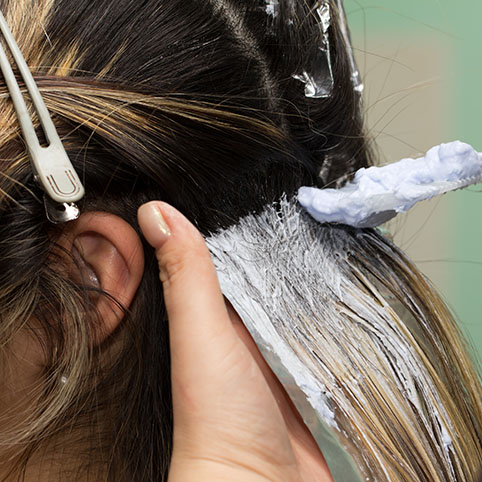
Photo: Deposit Photos
Do hair dyes cause cancer?
Remember the ad line, “only your hairdresser knows for sure?” Well, he or she may not really know for sure if hair dye can cause cancer. Science is not conclusive either yet.
Hair coloring has been done for centuries. The Romans used the reddish brown dye, henna. Berries, crushed nutshells, vinegar were ingredients along the way. The pink hair we are seeing today is nothing new. It was popular around 1914. L’Oreal is credited with the first commercial synthetic hair dye in 1907.
Over the years, many have wondered about the safety of hair dyes for those who choose to alter their natural hair and for those that apply the chemicals.
Scientists at the National Institutes of Health found that women who use permanent hair dye and chemical hair straighteners have a higher risk of developing breast cancer than women who don’t use these products. The study published online Dec. 4 in the International Journal of Cancer and suggests that breast cancer risk increased with more frequent use of these chemical hair products.
Using data from 46,709 women in the Sister Study, researchers at the National Institute of Environmental Health Sciences (NIEHS), part of NIH, found that women who regularly used permanent hair dye in the year prior to enrolling in the study were 9% more likely than women who didn’t use hair dye to develop breast cancer. Among African American women, using permanent dyes every five to eight weeks or more was associated with a 60% increased risk of breast cancer as compared with an 8% increased risk for white women. The research team found little to no increase in breast cancer risk for semi-permanent or temporary dye use.
“Researchers have been studying the possible link between hair dye and cancer for a long time, but results have been inconsistent,” said corresponding author Alexandra White, Ph.D., head of the NIEHS Environment and Cancer Epidemiology Group. “In our study, we see a higher breast cancer risk associated with hair dye use, and the effect is stronger in African American women, particularly those who are frequent users. ”
An intriguing finding was the association between the use of chemical hair straighteners and breast cancer. Dr. White and colleagues found that women who used hair straighteners at least every five to eight weeks were about 30% more likely to develop breast cancer. While the association between straightener use and breast cancer was similar in African American and white women, straightener use was much more common among African American women.
If you are scratching your head over the safety of hair coloring, the American Cancer Society offers good information:
Hair Dyes
Many American women, as well as a small but increasing number of men, use hair dyes. You may have heard rumors about a link between using hair dye and getting cancer. Many studies have looked at hair dyes as a possible risk factor for various types of cancer. Here we will discuss what the research shows so that you can make choices that are comfortable for you.
Types of hair dyes
Hair dyes vary greatly in their chemical make-up. People are exposed to the chemicals in hair dyes through skin contact. There are 3 main types of hair dyes:
Temporary dyes: These dyes cover the surface of the hair but don’t penetrate into the hair shaft. They generally last for 1 to 2 washings.
Semi-permanent dyes: These dyes do penetrate into the hair shaft. They typically last for 5 to 10 washings.
Permanent (oxidative) hair dyes: These dyes cause lasting chemical changes in the hair shaft. They are the most popular types of hair dyes, because the color changes last until the hair is replaced by new growth. These dyes are sometimes referred to as coal-tar dyes because of some of the ingredients in them. They contain colorless substances such as aromatic amines and phenols.
In the presence of hydrogen peroxide, these substances go through chemical reactions to become dyes. Darker hair dyes tend to use more of these coloring agents.
Concern about cancer risk is largely limited to the semi-permanent and permanent dyes. Because darker dyes have more of some chemicals that may cause cancer, these products are of greatest potential concern.
How are people exposed to hair dyes?
The most common way to be exposed is to dye your hair or have it dyed. Some chemicals in hair dyes can be absorbed in small amounts through the skin or inhaled from fumes in the air.
People who work around hair dyes regularly as part of their jobs, such as hairdressers, stylists, and barbers, are likely to be exposed more than people who just dye their hair on occasion. Many of the concerns about hair dyes possibly causing cancer have focused on people who work with them.
Do hair dyes cause cancer?
Researchers have been studying a possible link between hair dye use and cancer for many years. Studies have looked most closely at the risks of blood cancers (leukemias and lymphomas) and bladder cancer. While some studies have suggested possible links, others have not.
What do studies show?
Researchers use 2 main types of studies to try to figure out if a substance causes cancer. (A substance that causes cancer or helps cancer grow is called a carcinogen.)
In studies done in the lab, animals are exposed to a substance (often in very large doses) to see if it causes tumors or other health problems. Researchers may also expose normal cells in a lab dish to the substance to see if it causes the types of changes that are seen in cancer cells. In lab studies, researchers can control many of the other factors that might affect the results. Still, it’s not always clear if the results in lab dishes or animals would be the same in humans, for a number of reasons.
Another type of study looks at cancer rates in different groups of people. Such a study might compare the cancer rate in a group exposed to a substance to the rate in a group not exposed to it, or compare it to what the expected cancer rate would be in the general population. But sometimes it can be hard to know what the results of these studies mean, because many other factors that might affect the results are hard to account for.
In most cases neither type of study provides enough evidence on its own, so researchers usually look at both human and lab-based studies when trying to figure out if something might cause cancer.
Studying something like hair dyes can be even more complex because not all hair dyes are the same – they can contain any of thousands of different chemicals. On top of this, the ingredients in hair dyes have changed over the years. Early hair dyes contained chemicals, including some aromatic amines, which were found in the late 1970s to cause cancer in lab animals, so hair dye manufacturers changed some of the chemicals in their products. Studying exposure to hair dyes from decades ago may not be the same as studying current exposures. In fact, many studies classify personal hair dye use based on whether it took place before or after 1980.
Studies done in the lab
Some of the ingredients used in hair dyes (including certain aromatic amines) have been shown to cause cancer in lab animals, usually when the animals were fed large amounts of the dyes over a long period of time. Although studies have shown that some of the dye applied to an animal’s skin is absorbed into the bloodstream, most have not found a link between skin application and cancer risk.
It’s not clear how these results might relate to people’s use of hair dyes.
Studies in people
Most of the studies looking at whether hair dye products increase the risk of cancer have focused on certain cancers such as bladder cancer, non-Hodgkin lymphoma, leukemia, and breast cancer. These studies have looked at 2 groups of people:
- People who use hair dyes regularly
- People who are exposed to them at work
- Bladder cancer: Most studies of people exposed to hair dyes at work, such as hairdressers and barbers, have found a small but fairly consistent increased risk of bladder cancer. However, studies looking at people who have their hair dyed have not found a consistent increase in bladder cancer risk.
Leukemias and lymphomas: Studies looking at a possible link between personal hair dye use and the risk of blood-related cancers such as leukemia and lymphoma have had mixed results. For example, some studies have found an increased risk of certain types of non-Hodgkin lymphoma (but not others) in women who use hair dyes, especially if they began use before 1980 and/or use darker colors. The same types of results have been found in some studies of leukemia risk. However, other studies have not found an increased risk. If there is an effect of hair dye use on blood-related cancers, it is likely to be small.
Breast and other cancers: Most studies looking at hair dye use and breast cancer have not found an increased risk. For other types of cancer, too few studies have been done to be able to draw any firm conclusions.
Many people use hair dyes, so it is important that more studies are done to get a better idea if these dyes affect cancer risk.











